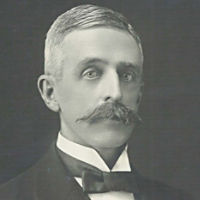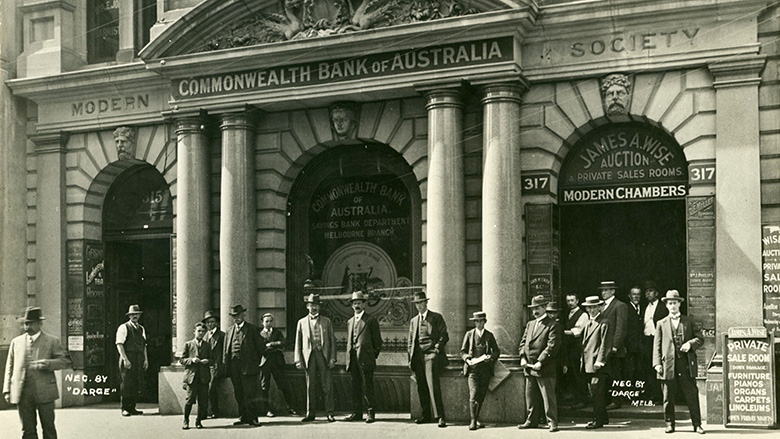From its initial foundations in 1912 to the significant company it has become today, the Commonwealth Bank continues to bear the personal imprint of the life-long banker who was charged with creating Australia’s first such publicly-owned financial institution.
Virtually every aspect of the fledgling CBA — and therefore the pillars on which the modern-day group now sits — owes its existence to Sir Denison Miller, the bank’s founding Governor (Chief Executive Officer and Managing Director in today’s terminology). The centenary of Miller’s death, in June 1923 at the premature age of 63, is commemorated this month.
“Without Miller’s guiding hand, the bank would not have become the strategically important and nation-building bank that it has become,” says Steven Politzer, a Group Archivist at Commonwealth Bank.
Founding Commonwealth Bank
Appointed by Andrew Fisher, the first Labor Prime Minister after Federation, Miller was granted extraordinary power and total decision-making to establish an organisation from a standing start in his own image – bringing to bear all of his knowledge, skills and experience in a banking career that at that point stretched back 36 years to the mid-1870s, when Australia was still a collection of British colonies.
 1912 political cartoon featuring featuring Federal Treasurer Andrew Fisher and Governor Denison Miller (Reserve Bank of Australia Archives)
1912 political cartoon featuring featuring Federal Treasurer Andrew Fisher and Governor Denison Miller (Reserve Bank of Australia Archives)
Miller had no Chair or board to report to, so he just got on with the job as quickly and as emphatically as he could. Events outside the control of even his impressive abilities would swiftly prove why he had little time to spare.
Charged with establishing a national savings bank, as the federal government’s bank to manage Australia’s “money” and in effect the country’s nascent Central Bank, Miller was offered the job in mid-May 1912 and started work just over two weeks later.
The bank he headed, however, was little more than a name on a brass plate on a small office in Melbourne where the fledgling federal administration was based. Miller was one of just three staff – himself, a Treasury staff member given to him on loan and a messenger. The first savings account was opened by the Prime Minister in person, who deposited one pound.
By the end of the day, a further 518 accounts had been opened with deposits totalling 8,325 pounds.
Starting small didn’t daunt Miller, who relished the opportunity to establish the new bank in his image. Travelling around the country and utilising his network of contacts, he personally recruited 126 people in the first six months of CBA’s operation, creating a senior management team and a back-office staff from scratch.
Between the end of December 1912 and the start of World War One in August 1914 – which became a defining moment in the bank’s history – Miller was directly involved in or oversaw:
- The opening of branches in all states and territories;
- Acquisition or leasing of numerous other premises;
- Establishing a new head office in Sydney;
- Creating regulations for the conduct of the bank;
- Ensuring all staff had a book of instructions that guided their work;
- Printing all the necessary forms to operate a bank;
- Establishing a nationwide network of agencies through the Post Office (the forerunner of today’s Bank@Post service);
- Setting up exchange facilities with other banks;
- Opening a branch in London, then the money market capital of the world;
- Adding trading bank operations to its savings bank role.
The onset of war
However, it was the outbreak of war which was to dramatically change the future direction of the bank and in doing so propel Denison Miller into a national figure of importance in the eyes of the Australian public.
As the nation’s bank, it underwrote the ever-increasing (and dramatically so) war effort since none of the privately-owned banks — singularly or collectively — would be able to fund the rapid growth in public debt.
The first bill for the cost of war was put at 40 million pounds — equivalent to more than $5 billion — of which the Australian government would have to find half. The other 20 million would come via a loan from the British government.
To cover Australia’s “share”, Denison Miller and the CBA took the lead in raising the first ever War Loan funded by peoples’ donations – savings that they invested with the promise of an interest payment on top when the loans were eventually repaid.
In all, 10 loans were offered between 1915 and 1921 – seven war loans and three peace loans – raising 250 million pounds at a cost that was much cheaper than sourcing them through the pricier commercial capital markets. CBA managed all of the loans and undertook high-profile public marketing campaigns – using models of ships and other military equipment paraded through the streets – to encourage citizens to buy the interest-bearing bonds.
Denison Miller was often seen atop a replica tank, leading these fund-raising campaigns. He also ensured the bank was on the “frontline”, organising the payment of weekly wages for the country’s servicemen both at home and near the battlefields and at camps abroad.
 Denison Miller atop a tank in Sussex Street, Sydney, in April 1918 (Reserve Bank of Australia Archives)
Denison Miller atop a tank in Sussex Street, Sydney, in April 1918 (Reserve Bank of Australia Archives)
CBA also bankrolled Australia’s vital export trade such as wheat, wool, meat and dairy products, and was instrumental in setting up a dedicated shipping line to support the war effort and played a key role in securing and managing the nation’s gold reserves.
Miller was acutely aware of the personal cost of the war and stayed in touch directly with CBA’s staff who enlisted and served during the conflict. More than 200 joined up, a significant proportion of the employees at the time, of whom 26 never returned. (Miller himself endured the tragedy of war, losing one of his three sons who volunteered for service.)
Such was the impact on the bank that in helping to fund the peace, the last of the loans raised from the public was re-named the Diggers Loan which was utilised to bring the troops home and to build houses for them. Miller was pictured at the time laying the first brick for one of the properties. All told, CBA built 1,777 homes at a cost of 1.5 million pounds and acquired a further 5,179 properties for 2.8 million pounds to house Australia’s returning heroes.
After the war ended, Miller steered the bank through the difficulties of economic recovery, especially following such large losses of men of working age, helped the nation survive the ravages of the Spanish Flu pandemic between 1918 and 1920 and set the course for CBA to play an ever-increasing role in Australia’s financial system.
Denison Miller’s legacy
Under his leadership, the bank opened more than 50 branches, expanded its agency network, grew through mergers with other savings banks, employed hundreds of staff — including the first women — and took the first steps towards managing, printing and issuing Australia’s banknotes as an extension of its evolving central bank functions.
Knighted in 1920 for his service to the bank and the country, Sir Denison Miller appeared to be omnipresent at the heads of an institution that personified the modern nation that Australia was becoming. But, still in his early 60s, he died suddenly from heart disease in 1923, just over halfway through his second term of office.
 Entrance to Commonwealth Bank's Martin Place office draped with black flags after Denison Miller's death in 1923 (Reserve Bank of Australia Archives))
Entrance to Commonwealth Bank's Martin Place office draped with black flags after Denison Miller's death in 1923 (Reserve Bank of Australia Archives))
Despite the shock of his passing, Miller had, in just 11 years, built from scratch a well-run, strongly-financed and strategically-minded bank – attributes which would serve it and the country well in the decades ahead.
Above all, it had remained true to the words of its founding Governor, spoken on the day of the opening of its Sydney head office back in 1916 : “No effort will be spared to make this national institution one of great strength and assistance in maintaining the financial equilibrium on safe lines so that its expansion may be concurrent with an ever increasing volume of wealth of the Commonwealth of Australia”.
Banner image: Denison Miller in 1916 (Reserve Bank of Australia Archives)
Go to CBA Newsroom for the latest news and announcements from Commonwealth Bank.





